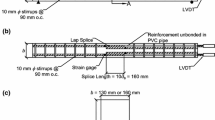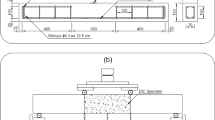Abstract
The results of experimental investigation of the local bond stress-slip response of steel bars embedded in confined concrete and subjected to cyclic loading are presented. Different types of confinement and their effect on the bond stress-slip response were evaluated and compared. These included internal confinement by ordinary transverse steel ties or steel fiber reinforcement, and external confinement by fiber reinforced polymer (FRP) composites. Beam specimens with spliced reinforcement at midspan were tested. The test parameters included the size of the steel bars, the ratio of concrete cover to bar diameter, and the amount of confinement. Without confinement, the specimens suffered significant bond deterioration and loss in load resistance in the first or second load cycle after bond splitting. Confining the concrete with transverse steel, steel fiber reinforcement or FRP composites within the splice region increased the bond strength and reduced the bond degradation with the number of loading cycles, leading to significant improvement in seismic performance. The envelope curve of the cyclic bond stress-slip response showed very good agreement with earlier test results obtained under static load conditions and the results predicted using an analytical model of the local bond stress-slip response of steel bars embedded in confined concrete.
Similar content being viewed by others
References
ACI Committee 408 (1992) State-of-the-art report on bond under cyclic loads. (ACI 408.2R92), American Concrete Institute, Detroit, 32 pp.
ACI Committee 408 (1990) Suggested development, splices, and standard hook provisions for deformed bars in tension. ACI 408.1R-90, American Concrete Institute, Detroit, MI, 3 pp.
Eligehausen R, Popov EP, Bertero VV (1983) Local bond stress-slip relationships of deformed bars under generalized excitations, Rep. UCB/EERC-83/23. Univ of Calif Berkeley, 162 pp.
Orangun CO, Jirsa JO, Breen JE Strength of anchored bars: a reevaluation of test data on development length and splices. Research Report No. 154-3F1975, Center for Highway Research, Univ. of Texas at Austin, 78 pp.
Orangun CO, Jirsa JO, Breen JE (1977) Reevaluation of test data on development length and splices. ACI Journal, Proceedings 74(3): Mar., pp. 114–122.
Zuo J, Darwin D (2000) Splice strength of conventional and high relative rib area bars and high-strength concrete. ACI Struct J, 97(4): July-Aug. pp. 630–641.
Harajli MH, Hamad BS, Rteil A (2004) Effect of confinement on bond strength between steel bars and concrete. ACI Struct J 101(5): September-October, pp. 595–603.
Filippou FC, Popov EP, Bertero VV (1983) Effects of bond deterioration on hysteretic behavior of reinforced concrete joints. Rep. UCB/EERC-83/19, Univ. of Calif., Berkeley, 184 pp.
Esfahani R, Rangan V (1998) Bond between normal strength and high-strength concrete (HSC) and reinforcing bars in splices in beams. ACI Struct J, 95(3): May-June, pp. 272–280.
Harajli MH, Mabsout ME (2002) Evaluation of bond strength of steel bars in plain and fiber reinforced concrete. ACI Struct. J., 99(4) July-Aug., pp. 509–517.
Harajli MH (2004) Comparison of bond strength of reinforcing bars in normal and high-strength concrete. Journal of Materials in Civil Engrg., ASCE, 16(4), Jul./Aug., pp. 365–374.
Azizinamini A, Stark M, Roller J, Ghosh S, (1993) Bond performance of reinforcing bars embedded in high-strength concrete. ACI Struct. J., 90(5), September-October, pp. 554–561.
American Concrete Institute (ACI) Committee 544 (1982) State-of-the-art report on fiber reinforced concrete. Concrete International: Design and Construction, 544.IR-82, Detroit, 9–30.
Naaman AE, Harajli MH (1990) Mechanical properties of high performance fiber concrete: a state-of-the-art report. Research Report No. SHRP-C/WP-90-004, Strategic Highway Research Program, National Research Council, Washington, D.C.
RILEM Proceeding Pro 39 (2004) Fibre-reinforced concrete–-BEFIB 2004, Proceedings of the Sixth International RILEM Symposium, 20–22 September, Varenna, Italy, Edited by M. Di Prisco, R. Felicetti, and G.A. Plizzari.
Parra-Montesinos GJ, Canbolat BA, Kim K (2004) Fiber reinforced cement composites for seismic resistant elements with shear dominated behavior, Proceedings of the Sixth RILEM Symposium, 20–22 Sept., Varenna, Italy, Vol. 2, pp. 1237–1246.
ACI Committee 440 (2002) Guide for the design and construction of externally bonded FRP systems for strengthening concrete structures, ACI 440.2R-02, American Concrete Institute, Det., MI.
Harajli MH, Hout M, Jalkh W (1995) Local bond stress-slip relationship of reinforcing bars embedded in fiber reinforced concrete. ACI Materials J. 92(4), Jul–Aug., pp. 343–354.
Author information
Authors and Affiliations
Rights and permissions
About this article
Cite this article
Harajli, M.H. Effect of confinement using steel, FRC, or FRP on the bond stress-slip response of steel bars under cyclic loading. Mater Struct 39, 621–634 (2006). https://doi.org/10.1007/s11527-005-9054-z
Received:
Accepted:
Published:
Issue Date:
DOI: https://doi.org/10.1007/s11527-005-9054-z




